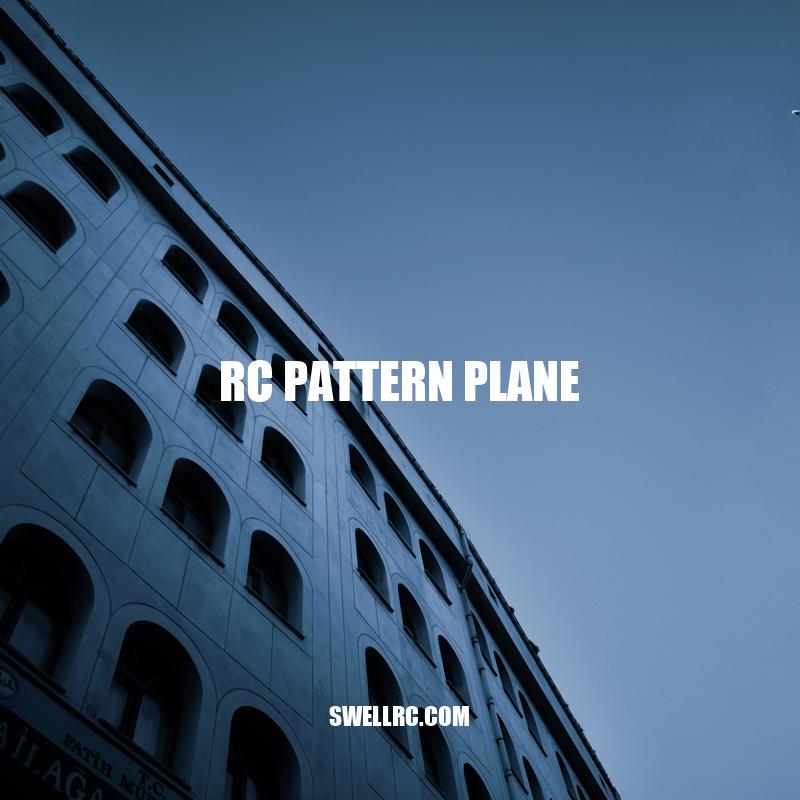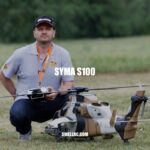RC Pattern Planes: A Guide to Flying and Choosing the Perfect Model
Remote control (RC) planes are a popular hobby among many aviation enthusiasts. These miniature planes, also known as model aircraft, are controlled by an operator on the ground using a handheld remote control device. There are different types of RC planes, each with unique designs and features. One such type is the pattern plane. Pattern planes are purpose-built for precision aerobatic flying, and they excel at performing a sequence of maneuvers with high accuracy and smoothness. These planes are modeled after full-sized aircraft that compete in international precision aerobatics events. They are capable of performing a variety of complex aerobatic maneuvers, including loops, rolls, stalls, and spin entries and exits. Pattern planes are typically constructed using lightweight materials to ensure maximum agility and performance. In the following paragraphs, we will dive deeper into the world of RC pattern planes, discussing the different types, how to choose the right one for your skill level, how to fly them, and possible modifications and upgrades to make.
What are RC Pattern Planes?
When it comes to RC planes, pattern planes are a unique type that stands out due to their precision aerobatic capability. Below are some of the features that make RC pattern planes stand out from the rest:
- Intended specifically for precision aerobatic flying
- Designed to perform a precise sequence of maneuvers with high accuracy and smoothness
- Modeled after full-sized aerobatic aircraft
- Constructed using lightweight materials for maximum agility and performance
- Capable of executing complex aerobatic moves such as loops, rolls, stall turns, and spins
- They typically have symmetrical wings to enable inverted flying as well as other complex maneuvers
Some popular RC pattern planes include the AeroPlus RC Addiction XL, the Extreme Flight Laser EXP, and the 3D Hobby Shop 92″ Edge 540. These planes are available in both ARF (Almost Ready to Fly) and RTF (Ready to Fly) kits and differ in their design, specifications, and flight performances. RC enthusiasts can visit websites such as Tower Hobbies, Horizon Hobby, and Graves RC Hobbies to find more information on the different models and brands of RC pattern planes available in the market.
What are the features of the RC plane?
RC planes are replicas of real-life aircraft that are flown remotely using a radio-controlled system. The features of an RC plane vary depending on the model and manufacturer, but some common features include:
- Wingspan: typically ranges from 20 inches to 60 inches, depending on the size of the plane
- Power source: most RC planes are powered by an electric motor, but some use gas or jet engines
- Materials: RC planes can be made of foam, balsa wood, or other lightweight materials
- Controls: the pilot uses a handheld transmitter to control the elevators, rudder, and throttle of the plane
- Flight time: the battery life of an RC plane can range from 5 minutes to over an hour, depending on the model and battery type
- Flight speed: RC planes can reach speeds of up to 150 mph, but average rates are around 30-60 mph
- Flight capabilities: some RC planes have advanced flight capabilities, such as 3D maneuvers, aerial photography, and First-Person View (FPV) video streaming capabilities
To find out more about RC planes and their features, visit websites such as Horizon Hobby or Hobbyking. These websites offer a variety of RC planes and related products, as well as helpful tips and advice for RC enthusiasts.
How to Choose the Right RC Pattern Plane
Choosing the right RC pattern plane that suits your level of experience and flying preferences is crucial to ensure safety and maximum enjoyment. Here are some factors to consider when choosing an RC pattern plane:
- Skill level: Novice pilots should choose planes that have gentle and predictable flight characteristics, while advanced pilots can handle more complex and agile planes
- Power source: RC pattern planes can be powered by either electric, gas, or nitro engines, and each type has its own advantages and disadvantages
- Wingspan and weight: The wingspan and overall weight of the plane affect its stability, speed, and maneuverability. Beginners may want to consider planes with lower wing loading as they are easier to handle
- Budget: The price of RC pattern planes can vary widely, from a few hundred dollars for an ARF kit to thousands of dollars for custom-built models
Additionally, many RC pattern planes also come with different features and accessories that can enhance the flying experience. Some essential accessories include a transmitter, servos, receivers, batteries, and charger.
A comparison table can be helpful for selecting an RC pattern plane. Below is a table comparing the features of three popular RC pattern planes:
| Model | Wingspan | AUW (All-Up Weight) | Power source |
|---|---|---|---|
| AeroPlus RC Addiction XL | 81 inches | 8.5 – 9.5lbs | Electric or gas engine |
| Extreme Flight Laser EXP | 91 inches | 10 – 11lbs | Electric or gas engine |
| 3D Hobby Shop 92″ Edge 540 | 92 inches | 11 – 12lbs | Electric or gas engine |
Before making a purchase, it is recommended that you research online to find reviews and ratings from other users. Websites such as Flying Giants, RC Universe, and RC Groups are excellent resources for finding helpful information about RC pattern planes.
What is the best wing shape for an RC plane?
The best wing shape for an RC plane depends on various factors, including the design and purpose of the plane. However, some of the commonly used and preferred wing shapes include:
- Elliptical wing
- Tapered wing
- Straight wing
- Swept wing
- Delta wing
Each of these wing shapes has its own advantages and limitations, and choosing the best one requires careful consideration of various factors, such as the intended flight characteristics, weight and balance of the plane, and the desired skill level of the pilot.
Several websites offer detailed information on selecting the best wing shape for an RC plane, such as Flite Test, which provides helpful tips and resources for RC plane enthusiasts. Additionally, some RC plane manufacturers offer planes with various wing shapes, such as Horizon Hobby’s E-flite line of planes with different wing configurations to suit different flying styles.
Flying an RC pattern plane can be challenging, but with practice and proper technique, it can also be rewarding. Here are some tips for beginners on how to fly an RC pattern plane successfully:
- Start with a basic flight plan: Before taking off, plan out the basic maneuvers you want to practice and try to stick with them until you have mastered the techniques. This will help you build confidence and gain experience.
- Pay attention to weather conditions: Wind and other weather conditions can significantly affect the flight of an RC pattern plane. For beginners, it is best to choose calmer days with fewer distractions and obstacles in the flying environment.
- Practice takeoff and landing: The takeoff and landing can be the most challenging part of the flight for beginners. Practice these maneuvers in a safe and open area, ideally with a clear runway or landing strip.
- Master basic maneuvers: Start with basic maneuvers such as straight and level flight, gentle turns, and basic loops before moving on to more complex maneuvers.
- Be familiar with the controls: Familiarize yourself with the controls of your RC pattern plane, including the throttle, elevator, rudder, and ailerons. Learn how each control affects the flight of the plane.
Additionally, one of the best ways to improve your flying skills is by seeking help or guidance from experienced pilots. Joining local flying clubs or attending workshops and training sessions can provide you with valuable tips and insights from seasoned pilots.
There are also many online resources available that can help you learn more about flying techniques and practices. Websites such as RC Fliers Online, RC Airplane World, and Remote Control Airplanes Guide offer comprehensive guides and tutorials on flying RC pattern planes.
Remember, practice makes perfect when it comes to flying an RC pattern plane. With persistence and dedication, you can become a skilled pilot and enjoy the thrill of flying your RC pattern plane for years to come.
Where do I start with RC planes?
Are you interested in learning how to fly RC planes? Here are a few steps to get you started:
1. Join a local RC flying club to connect with experienced flyers and learn about local regulations.
2. Find a suitable beginner RC plane. Look for options specifically designed for beginners.
3. Invest in a good quality remote control. A basic 4-channel transmitter is usually enough to get started.
4. Practice on a simulator before flying your actual plane to get comfortable with the controls.
5. Start with basic maneuvers such as takeoff, landing, and flying in a straight line before progressing to more complex maneuvers.
For more information on getting started with RC planes, check out the websites of popular RC plane manufacturers like Horizon Hobby and RCGroups.com which has a wealth of information about all aspects of RC flying.
RC pattern planes can be modified and upgraded to improve their performance and enhance their appearance. Here are some modifications and upgrades that RC enthusiasts can make:
- Upgrading the motor: Swapping the stock motor for a higher quality or more powerful motor can improve the plane’s speed and power, making it more agile and responsive.
- Adding LED lights: Installing LED lights can not only make the RC pattern plane look more attractive but also make it more visible during low-light conditions.
- Upgrading the servos: Changing to high-quality and faster servos can improve the plane’s response time and control.
- Replacing the propeller: A high-quality propeller is an essential part of an RC pattern plane. Upgrading to a better propeller can improve the plane’s overall performance and increase its speed and power.
- Customizing the paint job: While not directly related to performance, customizing the paint job can make your RC pattern plane stand out on the field.
It’s essential to be knowledgeable when modifying or upgrading your RC pattern plane. Ensure that you have a clear understanding of how different modifications can affect the plane and its performance.
There are many websites and online forums available that can provide helpful information and advice on modifications and upgrades for RC pattern planes. Websites such as RCGroups, HobbyKing, and RC Universe offer extensive discussions and forums with experienced pilots and enthusiasts.
Whether you’re upgrading the motor or customizing the paint job, modifying and upgrading an RC pattern plane can be a fun and rewarding hobby. Just remember to approach it with caution and always put safety first.
What is the best material to make an RC plane?
The best material to make an RC plane depends on the type of plane and the level of experience of the builder. Here are some commonly used materials:
- Balsa wood: lightweight and easy to work with, good for beginners.
- Foam: versatile, inexpensive, and can be shaped easily. Ideal for electric planes.
- Carbon fiber: strong, lightweight, and durable. Great for high-performance planes.
- Composite materials: a mix of plastic and carbon fibers, offer strength and rigidity. Expensive but ideal for advanced builders.
It’s important to consider the weight, speed, and flight characteristics of the plane before choosing a material. Some popular websites for RC plane materials include HobbyKing, MotionRC, and Horizon Hobby.
Conclusion
In conclusion, RC pattern planes are a unique type of RC plane that offers a fun and challenging flying experience for pilots. With their unique design and performance capabilities, pattern planes have become increasingly popular among hobbyists and enthusiasts.
When choosing an RC pattern plane, it’s essential to consider your skill level, flying preferences, and budget. Taking your time to research and understand the different models and modifications can help you make an informed decision and avoid frustration and accidents.
Whether you’re a beginner or an experienced pilot, there are many modifications and upgrades available that can improve the performance and appearance of your RC pattern plane. Just remember to approach modifications and upgrades with caution and ensure that you have a clear understanding of how they can affect the plane and its performance.
Overall, RC pattern planes can provide a fun and challenging hobby for enthusiasts who enjoy aviation and technology. With the right skills, knowledge, and equipment, you too can master the art of flying an RC pattern plane.



